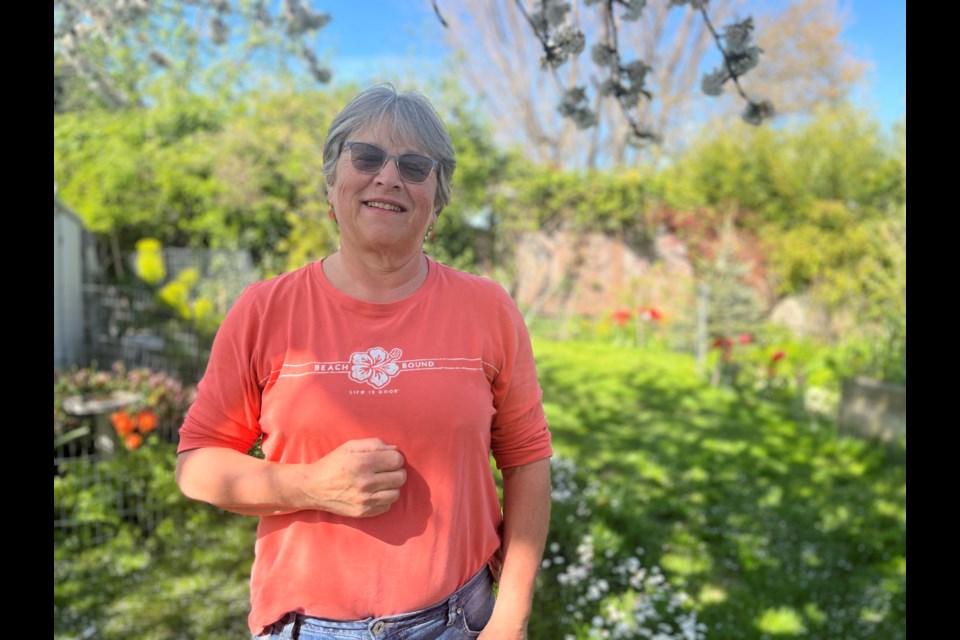There are many kinds of gardens and many kinds of gardeners. Some gardens are meticulously pruned, some look a little more on the wild side. Some gardeners focus on colourful flowers and others on clean landscaping.
Sometimes, the design of a green space is a reflection of a gardener's life philosophy; that's exactly how professional horticulturist, teacher and gardener Sarah Bacon sees the transformation of her Westview back and front yards over the past seven years.
Historically, homes in Westview had tidy green lawns, with great views, but no trees or shrubbery for shade. Bacon has created an inviting oasis, full of colourful flowers, shrubbery, trees and plants, which is inviting for humans, birds, her dogs and other creatures like bumble bees.
"Well, I hate lawns, and I like to think of what I do as rewilding," said Bacon. "I love gardening. I like doing anything that enhances the habitat, but also, it is friendly for the neighbourhood."
Not to say Bacon has a zero amount of what one would consider grass, but the difference is her patches of lawn have clover and English daisies growing in it.
"There is the maintenance and the artificiality," said Bacon, explaining why she finds lawns so irksome. "You're not listening to the environment when you install a lawn."
Bacon has slowly replaced the grass with clover and other things that don't have to be mowed or watered.
"It's less maintenance for sure," said Bacon. "But, I will confess, a couple of times a year, I'll edge the [garden] beds, and then every time I edge, I make the garden bigger and the lawn smaller, so I approach it a little bit at the time."
Bacon's approach to gardening is from a place of joy, a celebration of diversity, and letting-go, as opposed to a place of control, dominance and frustration over never-ending weed pulling. Still, Bacon said that doesn't mean she won’t plan and think about how she wants her garden and green spaces to look; she is planning all the time.
"All the plants on one side of the garden came in pots from where I used to live," said Bacon. "Now, I've put them in the ground, and they are mostly biennials, and they seed themselves."
Bacon was born in England and said North Americans have a misunderstanding of what an English garden is.
"Lawns in England are there as a framework for trees; it's pastoral, as opposed to being like a lawn-bowling green," added Bacon. "The lawn is not the be-all-end-all, but a supporting place."
Bacon said North Americans have tended to dig everything up in order to create a lawn that requires spending a lot of money on unsustainable products, such as fertilizer and pesticides for weeds.
In Bacon's backyard there is a giant cherry tree with branches that reach across the yard, providing shade and sustenance.
"The previous owner just chopped it, so we haven't touched it since because it's really hard on them," said Bacon. "All afternoon, all I can hear are birds."
After training as a horticulturist, Bacon worked for more than a decade in a variety of garden centres in the Lower Mainland, including Garden Works and Art Knapp. Later on, she trained as a public school teacher and taught high school science for many years.
Every square-inch of her backyard is filled with shrubbery, plants, flowers and garden boxes waiting for this year's planting season.
"The purple flowers that look like fireworks are amazing for the insects they get, and there's so many different kinds," said Bacon. "Then there is the ornamental poppy, and different kinds of Allium, and the foxgloves; they just grow."
Bordering the flower beds are herbs such as oregano and parsley that have flowered. For many gardeners, weeding is a constant chore, but for Bacon weeds don't need to be a stress.
"If there is space in-between plants, you get weed germination," said Bacon. "My sister says I over plant, but how I see it is, I try and plant leaving no space for weeds to grow."
Bacon said she will pull a weed here and there but doesn't stress over it, and doesn't use pesticides.
"The white flowers I have in my garden are called a money plant or Lunaria, but the seeds came from another garden, and it's growing. It's biennial, so one year it'll be little green seedlings, and the next year it will flower. Then, it has those cool see-through-seeds on them, for dried flower arrangements; for me, that's what makes a garden, that soft filler."
Join the Peak’s email list for the top headlines right in your inbox Monday to Friday.




